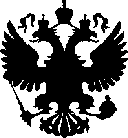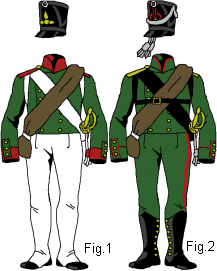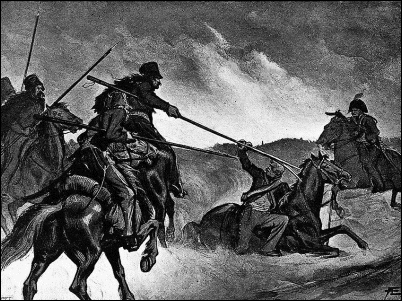The Russian Army

At the accession of Alexander I to the Russian Imperial throne, the empire had about 44 million citizens, meaning that the Czar had access to almost infinite numbers of manpower for his armies. The following article deals with the Russian Army of the Napoleonic Wars, with special emphasis on the Russo-Swedish war, of course. For more on the Swedish tactics and soldier, see the article Life in the Line of Fire.
The Infantry
When Catherine the Great died in 1796 all her military reforms were undone by mad Czar Paul. Instead the Russian army returned to an outdated form of military discipline and uniform á la Friedrich the Great. Many were the disastrous reforms of Czar Paul. Among other things he had steel plates fitted to the knees of the infantry soldiers, to teach them to march stiff-legged! When Russia had had enough of Paul I, he was assassinated and Alexander I took the throne. By the time of his accession, the army was in a terrible, outdated, state. The army Alexander inherited was vast. In 1795 The College of War counted its numbers to 541.741 men, 46.601 enrolled Cossacks, and in times of war a further 100.000 irregular cavalry could be mobilized. From 1796 to 1815, eighteen levies produced some 1.600.000 troops for the Czar's army.
The Russian army conscripted its soldiers. In some years there may be no levy at all, while in other years, mostly in times of national crisis, as in 1812, there could be as many as three levies. The soldiers there signed on for a service period of 25 years and were sent to the regimental depots for military training. Beteen 50-60.000 soldiers were being trained at all times. In this system the conscripts would be assigned units according to their length. The larger men would become Grenadiers, while the smaller became Jägers.
The Russian soldier sure possessed unique capabilities. As they came into the army from their lives in serfhood, they had a total obedience to their officers, their religion and to Czar and Mother Russia. The Russian soldier was a hard man, who could take hard treatment without arguing. In battle he was fierce. Countless are the eye witness accounts describing the individual bravery of the Russian soldiers, how seriously wounded men could still go about reloading their muskets as if on the field of manoeuvre, how individuals could still defend themselves with calm and bravery although cut off from their units and how dying soldiers never groaned, because this was forbidden! J S Stanhope remarked: "They really seemed to be made of different stuff than other men: their frames and sinews were, apparently, as hard as their brains."
 The Figures here beside show Russian infantry uniforms of the period. Figure 1, Russian grenadier uniform, Figure 2, Russian Jäger uniform.
The Figures here beside show Russian infantry uniforms of the period. Figure 1, Russian grenadier uniform, Figure 2, Russian Jäger uniform.
The Russian infantry regiments were named after the area in which they had been raised, their "inspections" (inspectorates), but by 1806 most of the inspections were discontinued and the infantry was divided into eighteen divisions instead, in the French manner. In the two years thereafter all the inspections were abolished. Three different regimental formations were used, these being Jäger, Grenadier and Musketeer regiments. The Jäger regiments were composed of two Jäger battalions and one Carabinier battalion, the Grenadier regiments of two Fusilier battalions and one Grenadier battalion, while the Musketeer (the Russians used this term, which was later abolished; it meant nothing more than ordinary light infantry though) regiments were composed of two Infantry battalions and one Grenadier. Each regiment consisted of 2.256 men, divided on three battalions, as mentioned. The Jäger regiments had 1.385 troops. On battalion level; each of the Grenadier and Musketeer battalions had one company of Grenadiers and three companies of Musketeers or Fusiliers. The Jäger battalion had one Carabinier company as well as three Jäger companies.
As otherwise in the Russian army, the infantry also relied heavily on cold steel. The Russian bayonet attack was fierce and well-known throughout Europe. In the war with Sweden, the attack with shining bayonets was used to greater effect than regular musket fire, by both sides. It was said on the Swedish side that the only language the Russian infantry understood was indeed the attack with cold steel.
When firing, the infantry would form the three-deep line, to maximise the effect of the firing. The most part of the officers were placed behind the lines to prevent the troops from fleeing away. A platoon of grenadiers was deployed on the right flank, while there stood a platoon of tirailleurs (sharp shooters) on the left flank. The entire line formation were divided into pairs of men, the second man fired his musket as the first reloaded. Manoeuvres were conducted on column formation. Jäger units made up a third of the Russian infantry.
80.000 men were indeed concentrated for the war against Sweden, however, only 50.000 were used in the operations. During the war, the Russian troops proved to be superior to the Swedish. This was indeed a result of the loyalty and blind faith in the Czar of the Russian soldier. Further, the Russian troops were battle-experienced, many of them having fought the French in Austria and Poland. Sweden faced an army of hardened veterans.
The Russian soldier was a tough enemy. Because "it was not enough to kill him, you had to push him over afterwards as well".
The Russian officers however, were a cruel and uneducated bunch. They often resorted to violence when either punishing their soldiers or marching them on. Examples of brutality are many. At the battle of Sävar 1809, Kamenskij had his guns fire away two shots in the back of his own troops as they were marching too slowly! The soldiers willingly accepted cruel punishment, including beatings with the cane, as because of their feudal serf-background they knew no other life. The higher ranks were, all according to the feudal laws of Russia, occupied by the nobility.
Barclay de Tolly, who was of Scottish descent, made an unusual career in the Russian military. Beginning in the lower ranks, he fought his way up and came to the notice of some important persons. During the Finnish War of 1808-09 he was in command of one of the columns of invasion. In 1810 he was made the Czar's Minister of War and also became commander of the First Army of the West. As Minister of War, he succeeded the conservative and incompetent Arakchev, who had been keeping on to the old theories of Paul I. Barclay de Tolly made applauded reforms to the Russian army. And in 1812 it met and defeated the leading military power of the day - Emperor Napoleon's La Grande Armée.
The massive Russian Cavalry
Russia had the greatest number of cavalry in Europe, and this depended much on the large body of Cossacks and irregular cavalry that were present at the Russian army as well as the fact that the great plains and steppes of the Russian motherland supported cavalry tactics. The massive irregular cavalry consisted of about 50.000 men, and in wartime this already great number could easily reach a 100.000 more.
In the Finnish War, the Russian armies, at most, had 11% of cavalry among them and the Swedish numbers were far less. Although that, there were hard cavalry skirmishes fought from time to time; like on the ice near Siikajoki on April 18, 1808 and at Kauhajoki, where Swedish dragoons turned over a force of Russian Hussars during the 1808 Summer Campaign.
The Russian cavalry fought according to the regulations of 1796; which stated that the attack should be performed on line formation, with the depth of two ranks. More ranks than two were considered outright dangerous. The cavarly relied heavily upon the sabre, the attack with cold steel, and the Russians actually withdrew the cavalry carbines by 1812. At the same time new cavalry regulations for tactics were introduced. The new regulations stated that the attack could be performed in two different ways, either the old, line formation, or on column of platoons.
 Overall, the quality of the Russian cavalry was well-known. The horses were impressing, the men were large and fearless, equipment was in perfect condition. However, the individual cavalrymen were often untrained in weapon skills and were often clumsy while handling their sabres. Reconnaissance and screening was left to the Cossacks. Another disadvantage for the Russian cavalry was its bad leadership. Had the Russian commanders understood the French manner of massing the attacks, and employed all the force of the cavalry, it would surely had been the finest and fiercest in Europe. The Cossack commander Platov, though, became something of a legend among his own troops for brilliant leadership.
Overall, the quality of the Russian cavalry was well-known. The horses were impressing, the men were large and fearless, equipment was in perfect condition. However, the individual cavalrymen were often untrained in weapon skills and were often clumsy while handling their sabres. Reconnaissance and screening was left to the Cossacks. Another disadvantage for the Russian cavalry was its bad leadership. Had the Russian commanders understood the French manner of massing the attacks, and employed all the force of the cavalry, it would surely had been the finest and fiercest in Europe. The Cossack commander Platov, though, became something of a legend among his own troops for brilliant leadership.
Without doubt the part of Russian cavalry that is the most interesting are the Cossacks. The Cossacks also played the most vital cavalry role in the war in Finland of 1808-09. The Cossack reserves of Russia were vast. The Cossacks rode and fought according to their Voisko, territory or district and home, led by their Atamans, tribal chiefs. The regiments were divided into Sotnias, squadrons. The free Cossacks had a major part in every Russian war during the Napoleonic period and helped win the wars. They were very much active against Sweden in 1808-09 as well. The most well-known Cossack Voiskos were Don (80 regiments of 500 troops each!), Black Sea, Bug and Orenburg. Further, there were Siberian, Ukrainian, Ural Cossacks as well as numerous smaller and less-known Voiskos.
Schwarzenberg described the Cossacks in 1812. "These organized bandits are wily. They do not like infantry fire very much, they detest artillery, but when they are three-to-one they become impudent." The Cossacks rode to war for plunder, adventure and the possibility of proving ones great courage, which they indeed admired. However, their ways of plundering and looting made them infamous in all of Europe. They made no distintion between friend and foe in that respect. John R. Elting describes this very well: "As looters, the Cossacks probably were international champions. There were recorded cases of their invading hospitals to jerk bandages from cloted wounds in search of any valuables that might be concealed under them."

Back to Articles
© Göran Frilund 2000-03, All Rights Reserved.
If you've surfed onto this page from outside and there is no menu on the left,
CLICK HERE for the full Website.


 The Figures here beside show Russian infantry uniforms of the period. Figure 1, Russian grenadier uniform, Figure 2, Russian Jäger uniform.
The Figures here beside show Russian infantry uniforms of the period. Figure 1, Russian grenadier uniform, Figure 2, Russian Jäger uniform. Overall, the quality of the Russian cavalry was well-known. The horses were impressing, the men were large and fearless, equipment was in perfect condition. However, the individual cavalrymen were often untrained in weapon skills and were often clumsy while handling their sabres. Reconnaissance and screening was left to the Cossacks. Another disadvantage for the Russian cavalry was its bad leadership. Had the Russian commanders understood the French manner of massing the attacks, and employed all the force of the cavalry, it would surely had been the finest and fiercest in Europe. The Cossack commander Platov, though, became something of a legend among his own troops for brilliant leadership.
Overall, the quality of the Russian cavalry was well-known. The horses were impressing, the men were large and fearless, equipment was in perfect condition. However, the individual cavalrymen were often untrained in weapon skills and were often clumsy while handling their sabres. Reconnaissance and screening was left to the Cossacks. Another disadvantage for the Russian cavalry was its bad leadership. Had the Russian commanders understood the French manner of massing the attacks, and employed all the force of the cavalry, it would surely had been the finest and fiercest in Europe. The Cossack commander Platov, though, became something of a legend among his own troops for brilliant leadership.